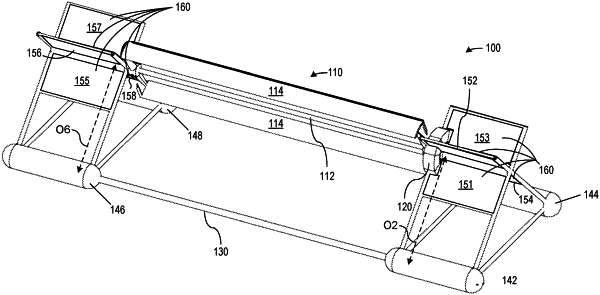| CPC F03B 13/16 (2013.01) [F03B 13/10 (2013.01); F05B 2220/32 (2013.01); F05B 2240/95 (2013.01)] | 21 Claims |

|
1. A system comprising:
a wave energy converter including a rotor on a central shaft connected to a generator, the rotor including one or more hydrofoils extending parallel to the central shaft and positioned to interact with waves, thereby creating lift that rotates the rotor and the central shaft; and
a frame on which the generator is fixedly mounted, with the rotor being able to rotate about a rotation axis of the central shaft to drive the generator, the frame comprising:
a first structure attached to the frame at a first offset from the rotation axis, the first structure having a first buoyancy that is adjustable by filling the first structure with an adjustable amount of a gas, liquid, or solid material; and
a second structure attached to the frame at a second offset from the rotation axis, the second structure having a second buoyancy that is adjustable by filling the first structure with an adjustable amount of a gas, liquid, or solid material, wherein:
the system has a first ballast configuration in which the first buoyancy and the second buoyancy cause the frame to float in water with at least a portion of the wave energy converter above a surface of the water;
the system has a second ballast configuration in which the first buoyancy and the second buoyancy are controlled to submerge the wave energy converter in the water, wherein a buoyancy difference is constant, the buoyancy difference being a difference between the first buoyancy and the second buoyancy, the buoyancy difference causing a first torque on the frame about the rotation axis that opposes a second torque on the frame produced by operation of the wave energy converter; and wherein
the first offset and the second offset are oriented so that the first torque increases in magnitude in response to rotation of the frame by the second torque, the first torque thereby limiting a range of rotation of the frame that operation of the wave energy converter causes.
|